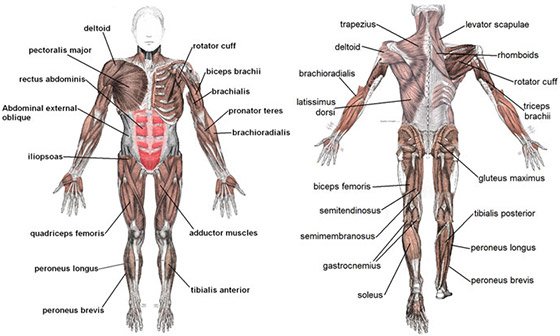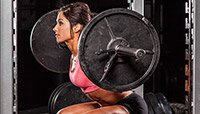You hear it time and again from females in and out of the gym, when it is suggested to them that they either a) lift weights, or b) increase the weight that they are lifting. "I don't want to do that, because I don't want to look like a man."
Many people, males included, have come to believe that for a female to lift weights means that she will somehow transform into the stereotype image of the female bodybuilder. This is simply NOT the reality of females and resistance training.
This article will discuss and compare the physiology, the hormonal adaptations to resistance training, and the role of diet in gaining muscle, in both males and females.
Physiology
Whilst males and females are structurally similar, there are many physiological differences that affect the sexes' ability to gain muscle mass.
Hormones

The primary reason that females cannot gain muscle mass as fast or to the extent as males is the difference in hormone status.
Testosterone is one of the androgenic hormones responsible for anabolism in the body (Kraemer & Ratamess). It is testosterone that is responsible for masculine traits (i.e. excess hair (especially facial), deepening of voice, increase in muscle mass).
Both males and females produce testosterone, as it is necessary for hormonal balance and body function (Marieb, 2004). However, males have much higher levels of testosterone than females, with the 'normal' range of total testosterone (in the bloodstream) being 0.95-4.3 pg/dl, compared to the 0.7-3.6 pg/dl of females.
However, it is not so much the total amount of testosterone that an individual has that determines their potential/ability for muscle growth, since most of the testosterone in the body is bound to either sex hormone binding globulin (SHBG) or other non-specific proteins such as albumin (Wheeler, 1995), but their levels of FREE testosterone (i.e. the amount of testosterone that is NOT bound in the body).
In males 0.3-5% (with an average of 2%) of their total testosterone if free, with their free testosterone normal values being 270-1100 ng/dl, compared to only 6-86 ng/dl of free testosterone available to females.
The female 'equivalent' of testosterone is estrogen (Marieb, 2004). Whilst estrogen may increase Growth Hormone (GH), it also increases a) SHBG, which decreases the amount of free testosterone in the body; and b) cortisol, which reduces muscle mass (Hakkinen, 1989).
Muscle Fibers And Types
There is a similar distribution of the percentage of Type I, Type IIa, and Type IIb muscle fibers in both males and females. However, females have ~60-80% of the muscle cross-sectional area (CSA) and whole muscle anatomical cross-sectional area (ACSA) than that of males.

Therefore, despite the potential for muscle hypertrophy in a relatively short period of time (Gregory, Stephen, Frederick, & Lemmer, et al., 2006), similar percentage increases in either muscle mass or volume as a result of resistance training, results in smaller total overall gains in CSA and ACSA in females than in males (Folland & Williams, 2007).
Resistance Training And Hormonal Adaptations
Studies have shown that resistance training acutely increases total testosterone in males (Hakkinen & Pakarinen, 1995); whereas there is NO change in females. However, free testosterone has been shown to be elevated up to 25% in females after resistance training (Nindl, Kraemer, Gotshalk, & Marx, et al., 2001).
Yet, because females have less free testosterone than males at rest, any increase is not significant enough to allow for muscle hypertrophy to the extent of a male. Therefore, it has been suggested that other anabolic hormones, such as GH may be responsible for hypertrophy in females (Kraemer & Ratamess, 2005).
Role Of Diet In Gaining Muscle
Diet is an important component of gaining muscle mass. To gain muscle mass one needs to be eating more than maintenance calories. Because females are generally smaller than males (i.e. smaller bone size and mass, less muscle mass, etc.), they generally require (and eat) less than males.

If a female ate the amount that a male ate to gain mass, they would most likely end up gaining a lot of unwanted body fat along with muscle hypertrophy. Females are also generally more prone to eating disorders such as anorexia and bulimia, etc. that are detrimental to muscle hypertrophy, and cause muscle loss (Beals & Houtkooper, 2006).
Conclusion
Masculinization in females does not occur as a result of [heavy] weight training, but rather because of the excess of androgenic hormones (i.e. testosterone) coupled with the correct stimulus for muscle growth (i.e. chronic resistance training and diet directed at muscle growth).
The stereotype image of the female bodybuilder in the media is a result of said females chronically using androgenic compounds (i.e. steroids) in order to increase their muscle mass and size. For the female who is not doing this, they can lift as hard and as heavy as they want, and will come nowhere close to "looking like a man."
References
- Beals, K. A. & Houtkooper, L. (2006). Disordered eating in athletes. In L. Burke & V. Deakin (Eds.). Clinical sports nutrition (3rd ed.). (p. 201-226).
- Folland, J. P. & Williams, A. G. (2007). The adaptations to strength training: Morphological and neurological contributions to increased strength. Sports Med, 37(2). (p. 145-168).
- Gregory, F. M., Stephen, M. R., Frederick, M. I., Lemmer, J. T., Tracy, B. L., Hurlbut, D. E., Metter, E. J., Hurley, B. F. & Rogers, M. A. (2006). Age and sex affect human muscle fibre adaptations to heavy-resistance strength training. Exp Physiol, 91(2). (p. 457-464).
- Hakkinen, K. (1989). Neuromuscular and hormonal adaptations during strength and power training: A review. J Sports Med Phys Fitness, 29. (p. 9-26).
- Hakkinen, K. & Pakarinen, A. (1995). Acute hormonal responses to heavy resistance training in men and women at different ages. Int J Sports Med, 16. (p. 507-513).
- Kraemer, W. J. & Ratamess, N. A. (2005). Hormonal responses and adaptations to resistance exercise and training. Sports Med, 35(4). (p. 339-361).
- Marieb, E. N. (2004). Human anatomy & physiology (6th ed.). San Francisco, CA, USA: Pearson Benjamin Cummings.
- Nindl, B. C., Kraemer, W. J., Gotshalk, L. A., Marx, J. O., Volek, J. S., Bush, J. A., Hakkinen, K., Newton, R. U. & Fleck, S. J. (2001). Testosterone responses after resistance exercise in women: Influence of regional fat distribution. Int J Sport Nutr Exerc Metab, 11. (p. 451-465).
- Wheeler, M. J. (1995). The determination of bioavailable testosterone. Ann Clin Biochem, 32(4). (p. 345-357).
Recommended For You

8 Reasons Women Should Lift Weights
If running and yoga are the cornerstones of your fitness plan and you aren't seeing the results you want, try resistance training. Here are eight reasons why weights rule the gym!
Health And Fitness Tips For The Busy Mom
This Mother's Day, celebrate fitness! These 5 fit moms share their hints and strategies to help you and your family stay fit, healthy, and happy.
